| |
Using The Warnholz Mini BiVo Small Mating Nuc
The Mini BiVo is so small that it is difficult to use, especially for beginners. With a few extra accessories this device can be rendered more useful for both small scale and large scale users.
|
|---|

The BIBBA stand at the 2009 National Honey Show was close to the stand of E.H. Thorne, they were selling a type of mating nuc that I had never seen before, it is similar to an Apidea, but has only two frames, which are smaller than those of the Apidea.
I was manning the BIBBA stand and my first thoughts were that the Mini BiVo was so small that it would be difficult
to use and that it would be especially difficult for a beginner to achieve any useful results.
(The circumstances of this incident can be found here that shows the generosity of Dave Cushman. R.P.)
During slack times on the stand I was able to put in a good deal of thought into how this device could be rendered more useful for small scale and large scale users alike.
What I have come up with has not been tested or proven, but each individual feature has been tested in some way or another in the past, the designs are based on a large amount of knowledge and a great deal of experience of mating nucs, so although untested I have no hesitation in saying that the methods proposed will be successful.
|
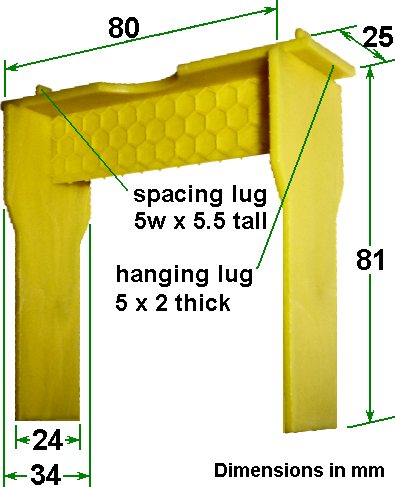
The small frames are injection moulded in one piece and they include a starter strip of plastic that has a hexagon pattern on it. There is a semicircular cut-out in one side of the top bar so that two such cut-outs can be opposed and used as a hole through which to introduce the queen cell. There are two spacing lugs on the upper surface of the topbar that will stop any Cobex* inner cover from sagging enough to obstruct the bee space over the frame tops.
The starter strip is not coated with beeswax, but I think they would benefit from this, just brush on clean melted beeswax using a cooking or basting brush, a minor feature, but one that will speed up the relatively difficult process of getting the frames drawn out.
Getting the bees to draw these small frames in the nuc itself would be very difficult, so we need to provide some assistance for the act of comb drawing. I will offer two methods, the first of these is a carrier frame that will allow a small number to be drawn in a National hive.
The adaptor frame depicted below will allow up to six of the Mini BiVo frames to be drawn in a National brood box. Feeding of syrup is to be advised while this is happening. I would not recommend more than one of these frames is intoduced per colony at any one time, but once one frame has been part completed further one(s) could be inserted.
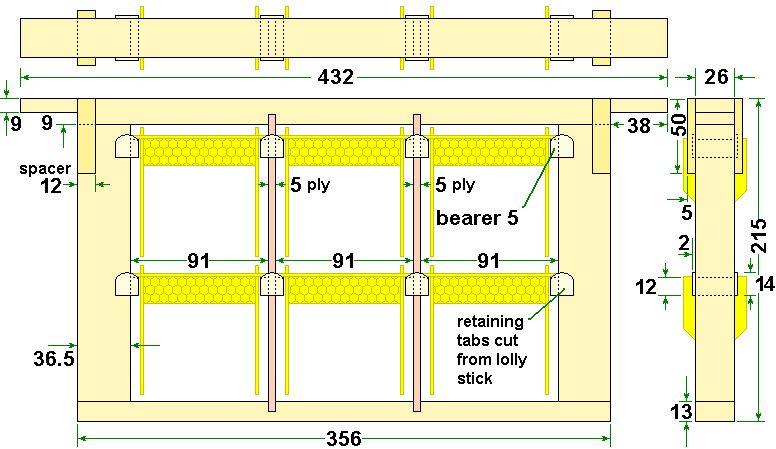
 The retaining caps are cut from hardwood lollipop sticks and need to be trimmed down to 15 mm width using a sharp craft knife or chisel. The small pads will require 1 mm pilot holes to be drilled for the 9 mm Gimp pins that secure them.
The retaining caps are cut from hardwood lollipop sticks and need to be trimmed down to 15 mm width using a sharp craft knife or chisel. The small pads will require 1 mm pilot holes to be drilled for the 9 mm Gimp pins that secure them.
Three is a sensible minimum for the number of Mini BiVo mating hives, even if only one queen is your aim as the extras give scope for selection and extra practice. However if one single Mini BiVo is being trialled, then it will be possible to use the introduction frame outlined below to get the two frames drawn, owing to the different design of the introduction frame which has some barriers on its face, it will take longer for the frames to be drawn and they may not get populated by brood.
The introduction frame is a little different...
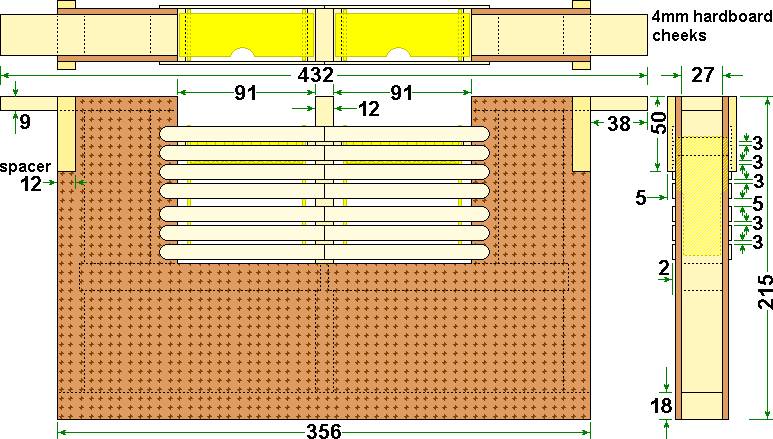
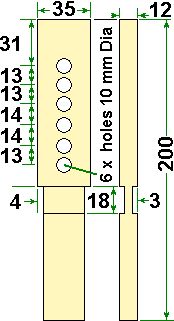 It uses another type of lollipop stick that is 10 mm x 114 mm, the spacing of these is important and you should first make two gauge pieces that are 3 mm wide and 5 mm wide, which are used to control the gaps precisely during assembly. Cut 4 mm off one end of each stick to enable a good butt joint to be made.
It uses another type of lollipop stick that is 10 mm x 114 mm, the spacing of these is important and you should first make two gauge pieces that are 3 mm wide and 5 mm wide, which are used to control the gaps precisely during assembly. Cut 4 mm off one end of each stick to enable a good butt joint to be made.
These designs are somewhat fiddly in construction and it is hoped that the appliance trade, may pick up on this and offer the devices for sale.
The internal framework is made from material 18 mm thick x 27 mm wide and some ends are rebated into the other members by 3 mm.
The septum between the two frames is quite important as it has to allow communication between the two small frames of bees and the drawing at right should clarify the details of this part.
The second method offered is for when large numbers of frames are to be drawn out, we require a similar technique to that used for Apidea mating nucs... which is a purpose built box that can fit on top of a National brood box.
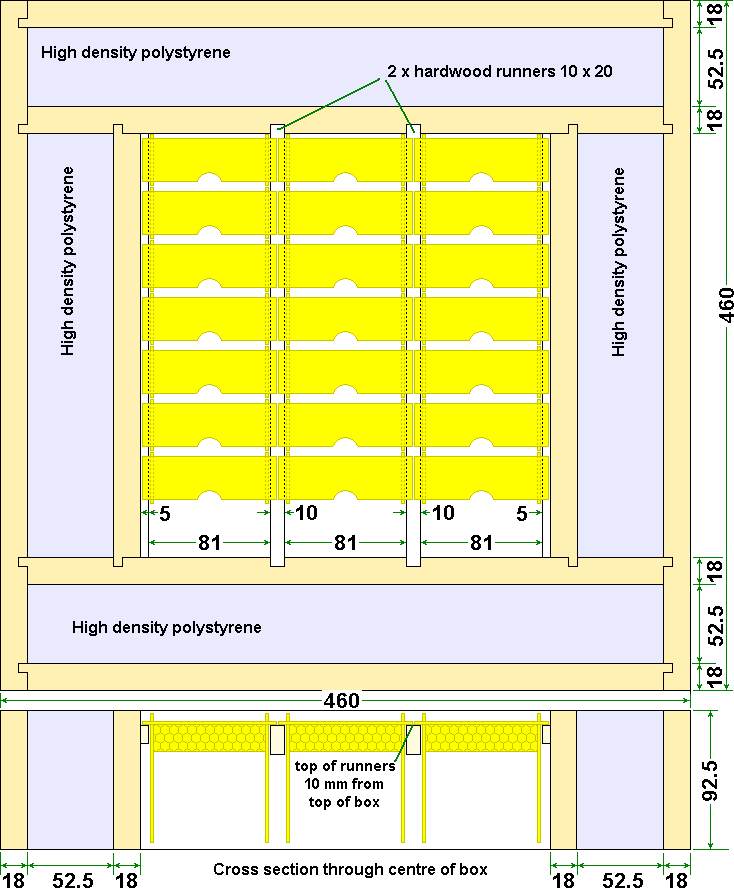
High density polystyrene is chosen for the insulation as it is too hard for the bees to chew to pieces, this insulation helps comb drawing at early and late parts of the season, particularly if used in conjunction with the insulated roof detailed at... Rational Roof
The box can hold twenty four BiVo frames and one row has been left out of the drawing to show rail construction and dimensions.
This design is suitable for both top or bottom bee space use and comb drawing would benefit from installation over a strong colony. Comb drawing, whether in a frame or box, does not require to be complete... the frames can be utilised in the mating nucs as soon as they have about 30% brood or stores deposited in them.
The Mini BiVo is intended to be filled from the bottom via the yellow plastic sliding panel. In order that feed is not spilled during this process we use fondant as the feed on first use. The fondant should be cut in irregular shaped bars about 20 mm x 20 mm, vary the sizes and angles of the faces of the bars so that they cannot stick together. Top up feeds will be done through the lid and will be syrup.
Even though we are providing drawn or part drawn frames, these nucs will benefit from confinement in a cool place for two or three days, although the more filled with sealed brood the better.
The number of bees used to fill the box... after some form of sorting to remove older bees, dampen the bees with weak sugar syrup using a small pressure spray. Measure the bees using a standard vending cup as detailed on the page... milkscoop.html But only fill the cup 70% full of bees.
* Cobex is a transparent plastic sheeting used for making sidecar windows and can be obtained from motorcycle accessory shops.
A very similar article has appeared in the Winter 2010 edition of
Bee Improvement Magazine
Dave Cushman
Printed from Dave Cushman's website Live CD version
Written... winter 2010,
Revised... 15 March 2010,
Source Code last updated...
|

|

|
|
|---|
|




 The retaining caps are cut from hardwood lollipop sticks and need to be trimmed down to 15 mm width using a sharp craft knife or chisel. The small pads will require 1 mm pilot holes to be drilled for the 9 mm Gimp pins that secure them.
The retaining caps are cut from hardwood lollipop sticks and need to be trimmed down to 15 mm width using a sharp craft knife or chisel. The small pads will require 1 mm pilot holes to be drilled for the 9 mm Gimp pins that secure them.

 It uses another type of lollipop stick that is 10 mm x 114 mm, the spacing of these is important and you should first make two gauge pieces that are 3 mm wide and 5 mm wide, which are used to control the gaps precisely during assembly. Cut 4 mm off one end of each stick to enable a good butt joint to be made.
It uses another type of lollipop stick that is 10 mm x 114 mm, the spacing of these is important and you should first make two gauge pieces that are 3 mm wide and 5 mm wide, which are used to control the gaps precisely during assembly. Cut 4 mm off one end of each stick to enable a good butt joint to be made.
